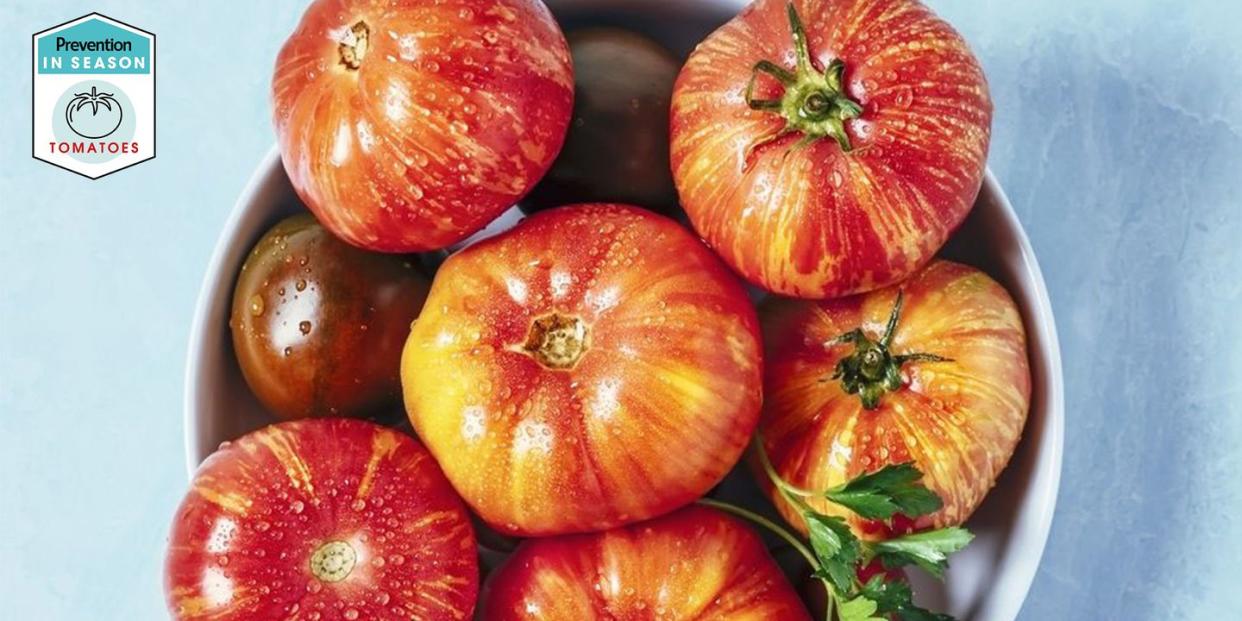August Is the Best Time to Eat Vitamin-Rich Tomatoes—Here’s How to Pick the Best Ones

"Hearst Magazines and Yahoo may earn commission or revenue on some items through the links below."
August means it’s peak summertime, and it’s the perfect opportunity to stock up juicy tomatoes. These versatile fruits (yes, they’re a fruit!) can be sweet or savory, pack in a ton of health benefits, and are the most delicious thing to eat right now.
Tomatoes are native to South America and came from the wild cherry variety cultivated by ancient Aztecs, according to FoodPrint, a project led by GRACE Communications Foundation to increase public awareness of current food systems and advocate for sustainable alternatives.
Tomatoes quickly spread to Europe through Spanish colonizers and became a regularly used ingredient in the 17th century. The Spanish brought tomatoes across the globe as they landed in the Caribbean, Southeast Asia, North America, and more, according to FoodPrint. In modern day, we see tomatoes popping up in cuisines all over the world from Italian marinara and Spanish gazpacho, to Middle eastern chopped salads and Chinese tomato stews.
If you’re all about tomatoes in the summertime like we are, grab the goodness of the summer’s most quality tomatoes at your local farmers’ market. We tapped farm and food experts for their go-to tips for finding the best tomatoes for your cooking style, and how to make the most of your farm market haul.
Taste test
Even if multiple farm stands in the same market are selling tomatoes, there’s probably a difference, explains Debra Moser, co-founder of Central Farm Markets in Washington D.C.. Though most tomatoes are sweet, slightly tart, and very acidic, the tomato variety, as well as how it’s grown, can affect the flavor and texture.
The key is to find a tomato that tastes good to you. Ask the farmer at the stand if you’re able to sample the tomatoes before you buy, or if sampling isn’t available, have them describe to you the specific flavor of each variety, Moser suggests. Some common varieties to look out for include:
Heirloom tomatoes. These meaty, firm, and colorful varieties vary in flavor; some are fruity and sweet, while others are earthy and tangy. They come from some of the oldest families of tomatoes (at least 50 years old, but can be hundreds of years old), and, since they’re usually not perfectly round or even red, they look less like a “perfect” tomato—but don’t be fooled. “These are really delicious. The flavor is totally intense,” says Moser. Try them sliced on sandwiches and salads or popped on the grill or in the oven.
Cherry tomatoes. These cherry-sized, deep-red varieties have a firm skin and candy-like sweetness. Snack on them by the handful or pop them on the grill or cook in a cast iron skillet to enhance the sugars.
Red beefsteak. These large, meaty tomatoes are milder and have a more classic tomato flavor. Slice them thick onto sandwiches or burgers.
Grape tomatoes. Characterized by their grape-like appearance, these juicy tomatoes are a great balance of sweet and tangy. Use in a salad, skewered on the grill, or snack with dip.
Roma tomatoes. For a tangier tomato, this meaty variety is perfect for blending into a sauce or slicing onto sandwiches.
The nutritionist says…
Tomatoes, whether from the local market or grocery store, boast tons of health benefits. “Tomatoes are a good source of vitamin C, potassium, folate, vitamin K, and plant compounds such as lycopene and beta carotene,” says Vandana Sheth, R.D.N., C.D.C.E.S., F.A.N.D., author of My Indian Table: Quick & Tasty Vegetarian Recipes. “Tomatoes may help decrease risk of heart disease and some types of cancers. They also can be helpful for skin health.”
Plus, though tomatoes are delicious and good for you raw, Sheth explains that cooking or steaming tomatoes can increase the availability of those plant compounds, like carotenoids and lycopene.
And if chemical use on your food is a concern for you, conventional tomatoes from the grocery store are often picked too early, ripened with chemicals (usually ethylene gas), and grown with pesticides, which can come through on your plate, explains Katherine Sacks, digital content manager at FoodPrint.
Alternatively, she suggests opting for organic tomatoes at your local store or farm market, which don’t have the same chemical concerns as conventional. But, many small farms don’t have the funding to become certified organic, even if they are following sustainable agricultural techniques, she explains. Shopping your local market gives you the opportunity to chat with your farmer about their specific farming methods to determine if they’re a certified organic farmer or using sustainable practices to protect their food from pests, she says.
When to stock up
The peak season of tomatoes in the dry, warm weather of California will differ from that of the cool, humid climate of upstate New York, but summer is the prime time to add tomatoes to your menu across the U.S. Sacks suggests shopping late July, August, and September for the best product available due to the generally warm climate across North America, which is optimal for the juicy fruit.
But Moser explains you may start seeing varieties like cherry tomatoes popping up as early as late March and lasting on farm stands through October. This is because many farmers use green houses that can extend the season. Be sure to ask your local farmer their methods to ensure the best product in the extended season.
Plus, if you’re catching late-season tomatoes that boast a bright green hue, many farmers sell under ripe, green tomatoes before the first frost, which are equally delicious to enjoy, according to Food Print.
How to pick the perfect tomato
Farmers and tomato fans alike know that using your senses is the best way to pick the best tomato. Go for the ripest tomato if you plan to eat the fruit within 48 hours, but slightly underripe pick best if you want them to hold out a couple of weeks. Try these farmer-approved tips when shopping:
See. Unlike other produce that need to ripen to a specific color before you can enjoy (we’ll pass on those reddish-white blackberries), tomatoes come in a variety of colors, shapes, and sizes. Some may be small, grape-sized fruits in a bright red hue, while others may be the size of a softball in an ombré of browns, reds, and greens. Because color isn’t a great indicator for tomatoes, be sure to check for little to no bruising, scarring, cracks, tears, or blemishes on the skin, says Moser.
Touch. A perfectly ripe tomato you plan to use that day should be firm but give just a little when lightly squeezed. If you want to use the tomatoes within the week, aim for a firmer option that will soften over time, explains Sacks.
Smell. Hold the tomato up to your nose and smell the aromas of the fruit. You should be able to get a good sense of how the interior of a ripe tomato smells from the outside.
What to do with your haul
Once you bring your batch of tomatoes home, be sure to use them right away or store appropriately using these tips.
Small tomatoes: Smaller tomatoes, like grape or cherry, tend to be a popular variety for farm stands in late summer. They have tougher skin and can be left on the counter in a bowl or even in the fridge to last longer, Moser says. Slice them in half and top salads, mix into a raw tomato salad to top grilled veggies or hamburgers, or cook them directly into your favorite frittata or shakshuka recipe.
Large tomatoes: Most large tomatoes (like heirloom or beefsteak) should be stored for no more than two weeks upside down on a counter instead of the fridge, and you should avoid them getting too close to other ripe fruits, suggests Moser. “When you store them in the fridge, you lose the tomato flavor and bring down the sugar content,” she warns.
Moser loves larger tomatoes sliced simply with tomato, mozzarella, basil, and salt (pro tip: a sharp, serrated knife is optimal for tomato slicing). And if you have too many to eat at once, she suggests preserving them for winter or blending them into gazpacho.
Imperfect tomatoes: Many farmers have a box of “seconds” available to purchase for a discounted price. These tomatoes aren’t perfect enough to sell or may have some small blemishes on them. Sacks suggests snagging these during the peak of the season and making the batch into tomato sauce or paste to use through the rest of the year. If you’re not able to use them right away, store as you would any other large or small tomato.
Superstar recipe

Tomato Toasts With Mint Yogurt and Sumac Vinaigrette
Celebrate gorgeous, juicy heirloom tomatoes with thick slices lightly seasoned to truly let their flavors shine. This recipe brings the perfect balance of toasty, crusty bread, creamy, cool yogurt, and bright, acidic tomatoes for the perfect summer snack as soon as you get home from the market.
You Might Also Like

